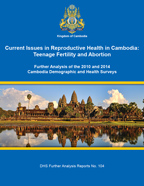There is no printed copy available to order.
Abstract:
This report explores issues related to
fertility among young women age 15-19 and to
abortion among women age 15-49 in Cambodia,
based on two Demographic and Health Surveys
(DHS) conducted in 2010 and 2014. In 2014,
approximately one in every eight young
Cambodian women age 15-19 either already had
a live birth or were currently pregnant with
their first child. Teenage fertility
increased from 8% in 2010 to 12% in 2014. In
general, teenage fertility in Cambodia rises
with increasing age, lower household wealth,
and lower levels of education. The proportion
of early childbearing is alarmingly higher
among young women without any education. The
largest fertility increase among young women
between the two surveys was found for those
with no education, from 17% in 2010 to 37% in
2014, an increase of 20 percentage points.
Teenage fertility also significantly
increased between surveys for women age 18,
women residing in rural areas, women in the
Great Lake and Plateau regions, women not
using a contraceptive method, and women
regularly exposed to the media. Teenagers
currently using contraceptive methods were
much more likely to have had a live birth
compared with non-users. Early childbearing
among young women in Cambodia is nearly
exclusively among those in union. It is
likely that a significant percentage of young
women start using a contraceptive method only
after giving birth to their first child.
The prevalence of abortion increased
significantly between the two surveys among
women age 15-49, from 5% in 2010 to 7% in
2014. Significant increases in abortion were
found for many subgroups: the largest were
for women in Phnom Penh region, at 7.1
percentage points, for women in the richest
wealth group, at 4.3 percentage points, and
women in urban areas, at 4.0 percentage
points. The reported increase in the abortion
rate in Phnom Penh region may be due to an
influx of young female migrant workers, among
whom contraceptive prevalence is much lower
than the national average. There was no
substantial increase in late-term abortion
between surveys (from 3.3% in 2010 to 3.7% in
2014). A significant increase in late-term
abortion was found only for the highest
wealth category (1.3 percentage points) and
for women in the Plain region (1 percentage
point). The prevalence of early abortion,
however, increased significantly from 2.6% in
2010 to 4.1% in 2014, particularly among
women with non-working husbands, from 1.4% to
10.3%, followed by women residing in Phnom
Penh, from 2.3% to 8.0%.
For overall abortion, late-term, and early
abortion, the odds of having an abortion were
significantly higher among currently
contraceptive users compared with non-users.
This was evident in both surveys, except for
late-term abortion in 2010. This finding
implies that following an abortion women are
trying to prevent another pregnancy by
adopting contractive use. A significant
proportion of abortions were performed by
unqualified providers (non-skilled birth
attendants) or outside of a health facility,
although such abortions are against the law
in Cambodia. Attendance by a skilled
attendant or performed at a health facility
was more common among women who had a late-
term abortion than among those with an early
abortion.
 Current Issues in Reproductive Health in Cambodia: Teenage Fertility and Abortion (PDF, 839K)
Current Issues in Reproductive Health in Cambodia: Teenage Fertility and Abortion (PDF, 839K)
